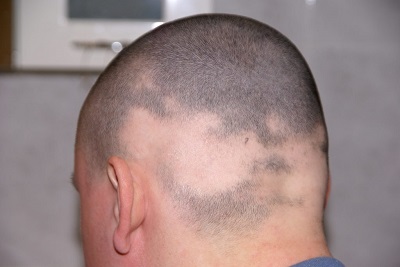 Alopecia Areata is an inflammatory response from ones immune system to the hair follicle causing focal areas of hair loss and in more severe cases a total loss of hair. Most commonly the loss is on the scalp but may occur on the eyebrow. We offer different treatment options from topical steroids, intralesional injections of Kenalog and targeted PUVA with the psoria-shield.
Alopecia Areata is an inflammatory response from ones immune system to the hair follicle causing focal areas of hair loss and in more severe cases a total loss of hair. Most commonly the loss is on the scalp but may occur on the eyebrow. We offer different treatment options from topical steroids, intralesional injections of Kenalog and targeted PUVA with the psoria-shield.
Facts About Alopecia Areata
Alopecia Areata affects two-hundred thousand people a year or about two (2) percent of the population at any one time. The appearance of Alopecia Areata is bimodal; it appears at two main age groups. It usually begins in a person’s early twenties (20’s). Alopecia Areata appears in children, however, it is less common.
Alopecia Areata is a chronic autoimmune condition that causes patches of inflammatory hair loss on the scalp, eyebrows, eyelashes and the beard area. It may also affect the axillae, extremities and the groin, as well.
Alopecia Areata is not an infection and it is not contagious. A person cannot “get it” by touching another person with Alopecia Areata. The condition is genetically linked (it is in the genes), but the heritability (how a person inherits the condition) is not yet understood. Usually, it is common that there are other autoimmune conditions in the person’s family, such as Systemic Lupus Erythematosus, Rheumatoid Arthritis, Graves Disease, Crohns Disease, and others.
Persistent Patchy Alopecia Areata – Patchy hair loss on the entire scalp.
Alopecia Totalis – Hair loss across the entire scalp.
Alopecia Universalis – Hair loss of the entire scalp and face (including eyebrows and eyelashes), plus the rest of the body (including pubic hair).
Diffuse Alopecia Areata – Sudden and unexpected thinning of the hair all over the scalp, this appears like other forms of hair loss such as Telogen Effluvium or male or female pattern hair loss.
Ophiasis – Unique pattern of hair loss, which includes the sides and lower back of the scalp (called the occipital region) in the shape of a band. It can be more difficult to treat, because it does not respond as quickly to medication.
Nail Pitting – Fine nail pitting is associated with all types of Alopecia Areata.
With all types of Alopecia Areata, hair loss and regrowth can be very unpredictable and cyclical (happen over and over), for many years. Though for some people, hair may regrow and not fall out again. Currently there is no cure. However, your hair follicles remain alive no matter what type you have. This means that hair regrowth can happen after many years of severe or widespread hair loss.
People with Alopecia Areata often suffer from comorbidities.
Conditions that may occur with Alopecia Areata:
- Autoimmune Thyroiditis
- Vitiligo
- Systemic Lupus Erythematosus
- Rheumatoid Arthritis
- Psoriasis
- Inflammatory Bowel Disease (Crohns Disease/Ulcerative Colitis)
- Diabetes Mellitus
- The prevalence of depression and or generalized anxiety is seen in over 1/3 of patients with the condition.
Treatment Options
There is no cure at this time. Treatments aim to reduce inflammation, scale development, slow the accumulation of skin cells, and remove plaques. Treatments fall into three categories: topical treatments, intralesional systemic medications, and light therapy.
Topical Treatments
Creams and ointments applied directly to the skin can be helpful for reducing mild to moderate Alopecia Areata.
Topical treatments include:
- Topical Corticosteroids
- Topical Retinoids
- Anthralin
- Vitamin D Analogues
- Salicylic Acid
- Moisturizers
Intralesional Treatments
Steroid (most often Kenalog) is injected directly and superficially to the areas affected by hair loss. This process usually is repeated up to three times at one month intervals. The potential side effects are atrophy (skin thinning that feels like a dent) at the site of the injections. Systemic absorption of the steroid is usually not an issue.
Systemic Medications
People with moderate to severe Alopecia Areata, and those who have not responded well to other treatment types, may need to use oral, subcutaneously injected or intravenously infused medications. The medications include:
- Oral Immune Suppressants (Methotexate, Cyclopsporine, Dapsone, Mycophenolate Mofetil, etc)
- JAK Inbitors (research and off label usage only)
- Biologic Therapy (Infliximab, Etanercept, Adalilumab, etc)
Light therapy
Therapeutic doses PUVA (Psoralen + Ultraviolet A Therapy) may be helpful in reducing symptoms of mild to moderate Alopecia Areata. PUVA is delivered in a phototherapy booth or by a hand held laser or LED source.



